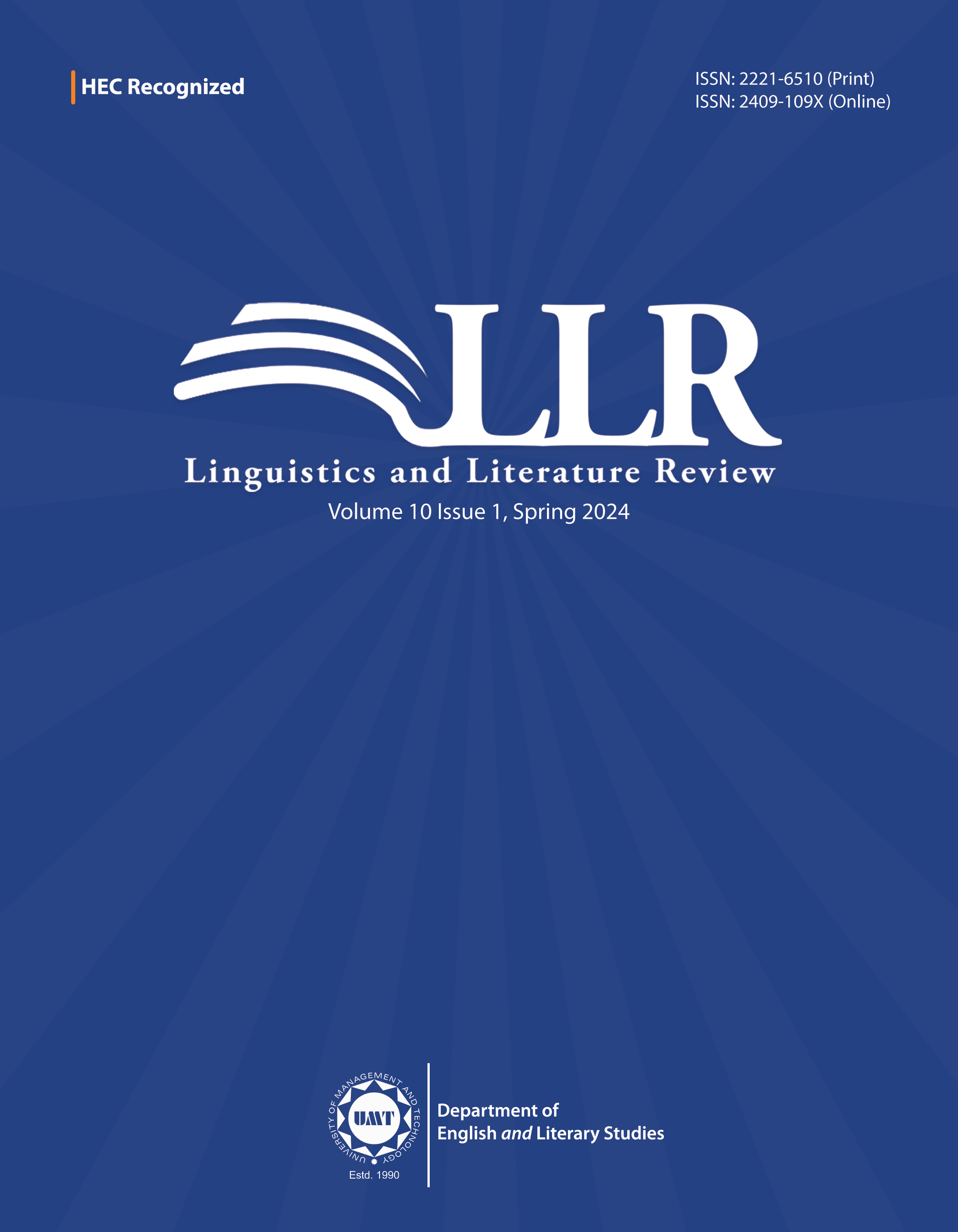An Acoustic Analysis of Vowel Nasalization in Pakistani English
Abstract
 Abstract Views: 0
Abstract Views: 0
Nasalization is allophonic in English but phonemic in many Pakistani languages. This has contributed to different degrees of nasalization in Pakistani English (PakE) vowels in nasal context as compared to British English (BE) vowels. The current study aims to acoustically investigate vowel nasalization in PakE using the parameters of A1-P1 and spectral flattening in a sample of PakE speakers with six different L1s, Sindhi, Punjabi, Pashto, Baluchi, Shina, and Urdu, to show similarities and differences with BE. A higher degree of nasalization was observed in CVN and NVN contexts throughout PakE speakers, regardless of L1, as compared to BE sample where nasalization was altogether absent in NVC context. While BE speakers nasalize vowels regressively, PakE speakers nasalize regressively and progressively.
Downloads
References
Archibald, J. (1998). Second language phonology, phonetics, and typology. Studies in Second Language Acquisition, 20(2), 189–211. https://doi.org/10.1017/S0272263198002046
Baumgardner, R. J. (1995). Pakistani English: Acceptability and the norm. World Englishes, 14(2), 261–271. https://doi.org/10.1111/j.1467-971X.1995.tb00355.x
Beddor, P. S. (1993). The perception of nasal vowels. In M. K. Huffman & R. A. Krakow (Eds.), Nasals, nasalization, and the velum (pp. 171–196). Academic Press.
Bell-Berti, F. (1993). Understanding velic motor control: Studies of segmental context. In M. K. Huffman & R. A. Krakow (Eds.) Nasals, nasalization, and the velum (pp. 63–85). Academic Press.
Chen, M. Y. (1997). Acoustic correlates of English and French nasalized vowels. The Journal of the Acoustical Society of America, 102(4), 2360–2370. https://doi.org/10.1121/1.419620
Cagliari, L. C. (1977). An experimental study of nasality with a particular reference to Brazilian Portuguese [Doctoral dissertation, University of Edinburgh, Edinburgh]. Edinburgh Research Archive. http://hdl.handle.net/1842/17275
Chen, N. F., Slifka, J. L., & Stevens, K. N. (2007). Vowel nasalization in American English: Acoustic variability due to phonetic context. Speech Communication, 49, 905–918.
Fujimura, O., & Lindqvist, J. (1971). Sweep-tone measurements of vocal-tract characteristics. The Journal of the Acoustical Society of America, 49(2B), 541–558. https://doi.org/10.1121/1.1912385
Hassan, A. (2016). Assimilation and incidental differences in Sindhi language. Eurasian Journal of Humanities, 2(1), 1–15.
House, A. S., & Stevens, K. N. (1956). Analog studies of the nasalization of vowels. Journal of Speech and Hearing Disorders, 21(2), 218–232. https://doi.org/10.1044/jshd.2102.218
Kluender, K. R., Diehl, R. L., & Wright, B. A. (1988). Vowel-length differences after voiced and voiceless consonants: An auditory explanation. Journal of Phonetics, 16, 153–169. https://doi.org/10.1016/S0095-4470(19)30480-2
Kluge D. C., Reis M. S., Nobre-Oliveira D., & Rauber A. S. (2008). Intelligibility of accented speech: The perception of word-final nasals by Dutch and Brazilians [Paper presentation]. Proceedings of V Jornadas en Tecnologia del Habla, Bilbao, Spain. http://lorien.die.upm.es/~lapiz/rtth/JORNADAS/V/pdfs/articulo/art_49.pdf
Ladefoged, P., & Disner, S. F. (2012). Vowels and consonants. John Wiley & Sons, Ltd.
Ladefoged, P., & Maddieson, I. (2001) Vowels of the World’s Languages. In C. Kriedler (Ed.), Phonology: Critical concepts. Routledge.
Maeda, S. (1982). A digital simulation method of the vocal-tract system. Speech Communication, 1(3-4), 199–229.
Mahboob, A., & Ahmer, N. H. (2004). Pakistani English: Phonology. In E. W. Schneider (Ed.), A handbook of varieties of English: A multimedia reference tool (pp. 1002–1017). Mouton de Gruyter.
Mahmood, R., Hussain, Q., & Mahmood, A. (2011). Phonological adaptations of English words borrowed into Punjabi. European Journal of Social Sciences, 22(2), 234–245.
Major, R. C. (2008). Transfer in second language phonology. In J. G. H. Edwards & M. L. Zampini (Eds.), Phonology and second language acquisition (pp. 63–94). John Benjamins Publishing Company.
McAllister, R., Flege, J. E., & Piske, T. (2002). The influence of L1 on the acquisition of Swedish quantity by native speakers of Spanish, English and Estonian. Journal of Phonetics, 30(2), 229–258. https://doi.org/10.1006/jpho.2002.0174
Pruthi, T., & Espy-Wilson, C. Y. (2007). Acoustic parameters for the automatic detection of vowel nasalization [Paper presentation]. 8th Annual Conference of the International Speech Communication Association, Antwerp, Belgium.
Rahman, T. (1990). Pakistani English: The linguistic description of a non-native variety of English. National Institute of Pakistan Studies.
Raza, W. (2008). Patterns of Pakistani English pronunciation and pedagogic priorities. Market Forces, 4(3), 102–112.
Rehman, I. (2019). Urdu vowel system and perception of English vowels by Punjabi-Urdu speakers (Publication No. 28130860) [Doctoral dissertation, University of Kent]. ProQuest Dissertation & Theses. https://doi.org/10.22024/UniKent/01.02.76180
Saleem, A. M., Kabir, H., Riaz, M. K., Rafique, M. M., Khalid, N., & Shahid, S. R. (2002). Urdu consonantal and vocalic sounds. Center for Research in Urdu Language Processing. https://www.readkong.com/page/urdu-consonantal-and-vocalic-sounds-6890362
Singh, P., & Lehal, G. S. (2010). Corpus based statistical analysis of Punjabi syllables for preparation of Punjabi speech database. International Journal of Intelligent Computing Research (IJICR), 2(1), 124–128.
Wali, A. (2003). The rules governing the writing-pronunciation contrast in Urdu: A phonological study. Center for Research in Urdu Language Processing. https://tinyurl.com/58x5ye64
Whalen, D. H., & Beddor, P. S. (1989). Connections between nasality and vowel duration and height: Elucidation of the Eastern Algonquian intrusive nasal. Language, 65(3), 457–486. https://doi.org/10.2307/415219
Zahid, S., & Hussain, S. (2012). An acoustic study of vowel nasalization in Punjabi [Paper presentation]. 4th International Conference of Language and Technology (CLT12), Lahore, Pakistan.
Zhanming, W. (2014). Review of the influence of L1 in L2 acquisition. Studies in Literature and Language, 9(2), 57–60. https://doi.org/10.3968/5721
Zobl, H. (1980). The formal and developmental selectivity of LI influence on L2 acquisition. Language Learning, 30(1), 43–57. https://doi.org/10.1111/j.1467-1770.1980.tb00150.x
Copyright (c) 2024 Maryah Khalfan, Uzma Anjum

This work is licensed under a Creative Commons Attribution 4.0 International License.

This work is licensed under a Creative Commons Attribution 4.0 International License. Authors retain copyright and grant the journal right of first publication with the work simultaneously licensed under a Creative Commons Attribution (CC-BY) 4.0 License that allows others to share the work with an acknowledgment of the work’s authorship and initial publication in this journal.







